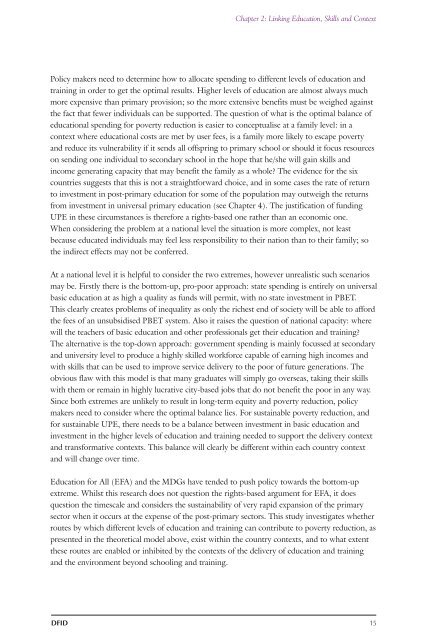Educating out of Poverty? A Synthesis Report on Ghana, India ... - DfID
Educating out of Poverty? A Synthesis Report on Ghana, India ... - DfID
Educating out of Poverty? A Synthesis Report on Ghana, India ... - DfID
Create successful ePaper yourself
Turn your PDF publications into a flip-book with our unique Google optimized e-Paper software.
Chapter 2: Linking Educati<strong>on</strong>, Skills and C<strong>on</strong>text<br />
Policy makers need to determine how to allocate spending to different levels <str<strong>on</strong>g>of</str<strong>on</strong>g> educati<strong>on</strong> and<br />
training in order to get the optimal results. Higher levels <str<strong>on</strong>g>of</str<strong>on</strong>g> educati<strong>on</strong> are almost always much<br />
more expensive than primary provisi<strong>on</strong>; so the more extensive benefits must be weighed against<br />
the fact that fewer individuals can be supported. The questi<strong>on</strong> <str<strong>on</strong>g>of</str<strong>on</strong>g> what is the optimal balance <str<strong>on</strong>g>of</str<strong>on</strong>g><br />
educati<strong>on</strong>al spending for poverty reducti<strong>on</strong> is easier to c<strong>on</strong>ceptualise at a family level: in a<br />
c<strong>on</strong>text where educati<strong>on</strong>al costs are met by user fees, is a family more likely to escape poverty<br />
and reduce its vulnerability if it sends all <str<strong>on</strong>g>of</str<strong>on</strong>g>fspring to primary school or should it focus resources<br />
<strong>on</strong> sending <strong>on</strong>e individual to sec<strong>on</strong>dary school in the hope that he/she will gain skills and<br />
income generating capacity that may benefit the family as a whole? The evidence for the six<br />
countries suggests that this is not a straightforward choice, and in some cases the rate <str<strong>on</strong>g>of</str<strong>on</strong>g> return<br />
to investment in post-primary educati<strong>on</strong> for some <str<strong>on</strong>g>of</str<strong>on</strong>g> the populati<strong>on</strong> may <str<strong>on</strong>g>out</str<strong>on</strong>g>weigh the returns<br />
from investment in universal primary educati<strong>on</strong> (see Chapter 4). The justificati<strong>on</strong> <str<strong>on</strong>g>of</str<strong>on</strong>g> funding<br />
UPE in these circumstances is therefore a rights-based <strong>on</strong>e rather than an ec<strong>on</strong>omic <strong>on</strong>e.<br />
When c<strong>on</strong>sidering the problem at a nati<strong>on</strong>al level the situati<strong>on</strong> is more complex, not least<br />
because educated individuals may feel less resp<strong>on</strong>sibility to their nati<strong>on</strong> than to their family; so<br />
the indirect effects may not be c<strong>on</strong>ferred.<br />
At a nati<strong>on</strong>al level it is helpful to c<strong>on</strong>sider the two extremes, however unrealistic such scenarios<br />
may be. Firstly there is the bottom-up, pro-poor approach: state spending is entirely <strong>on</strong> universal<br />
basic educati<strong>on</strong> at as high a quality as funds will permit, with no state investment in PBET.<br />
This clearly creates problems <str<strong>on</strong>g>of</str<strong>on</strong>g> inequality as <strong>on</strong>ly the richest end <str<strong>on</strong>g>of</str<strong>on</strong>g> society will be able to afford<br />
the fees <str<strong>on</strong>g>of</str<strong>on</strong>g> an unsubsidised PBET system. Also it raises the questi<strong>on</strong> <str<strong>on</strong>g>of</str<strong>on</strong>g> nati<strong>on</strong>al capacity: where<br />
will the teachers <str<strong>on</strong>g>of</str<strong>on</strong>g> basic educati<strong>on</strong> and other pr<str<strong>on</strong>g>of</str<strong>on</strong>g>essi<strong>on</strong>als get their educati<strong>on</strong> and training?<br />
The alternative is the top-down approach: government spending is mainly focussed at sec<strong>on</strong>dary<br />
and university level to produce a highly skilled workforce capable <str<strong>on</strong>g>of</str<strong>on</strong>g> earning high incomes and<br />
with skills that can be used to improve service delivery to the poor <str<strong>on</strong>g>of</str<strong>on</strong>g> future generati<strong>on</strong>s. The<br />
obvious flaw with this model is that many graduates will simply go overseas, taking their skills<br />
with them or remain in highly lucrative city-based jobs that do not benefit the poor in any way.<br />
Since both extremes are unlikely to result in l<strong>on</strong>g-term equity and poverty reducti<strong>on</strong>, policy<br />
makers need to c<strong>on</strong>sider where the optimal balance lies. For sustainable poverty reducti<strong>on</strong>, and<br />
for sustainable UPE, there needs to be a balance between investment in basic educati<strong>on</strong> and<br />
investment in the higher levels <str<strong>on</strong>g>of</str<strong>on</strong>g> educati<strong>on</strong> and training needed to support the delivery c<strong>on</strong>text<br />
and transformative c<strong>on</strong>texts. This balance will clearly be different within each country c<strong>on</strong>text<br />
and will change over time.<br />
Educati<strong>on</strong> for All (EFA) and the MDGs have tended to push policy towards the bottom-up<br />
extreme. Whilst this research does not questi<strong>on</strong> the rights-based argument for EFA, it does<br />
questi<strong>on</strong> the timescale and c<strong>on</strong>siders the sustainability <str<strong>on</strong>g>of</str<strong>on</strong>g> very rapid expansi<strong>on</strong> <str<strong>on</strong>g>of</str<strong>on</strong>g> the primary<br />
sector when it occurs at the expense <str<strong>on</strong>g>of</str<strong>on</strong>g> the post-primary sectors. This study investigates whether<br />
r<str<strong>on</strong>g>out</str<strong>on</strong>g>es by which different levels <str<strong>on</strong>g>of</str<strong>on</strong>g> educati<strong>on</strong> and training can c<strong>on</strong>tribute to poverty reducti<strong>on</strong>, as<br />
presented in the theoretical model above, exist within the country c<strong>on</strong>texts, and to what extent<br />
these r<str<strong>on</strong>g>out</str<strong>on</strong>g>es are enabled or inhibited by the c<strong>on</strong>texts <str<strong>on</strong>g>of</str<strong>on</strong>g> the delivery <str<strong>on</strong>g>of</str<strong>on</strong>g> educati<strong>on</strong> and training<br />
and the envir<strong>on</strong>ment bey<strong>on</strong>d schooling and training.<br />
DFID 15

















